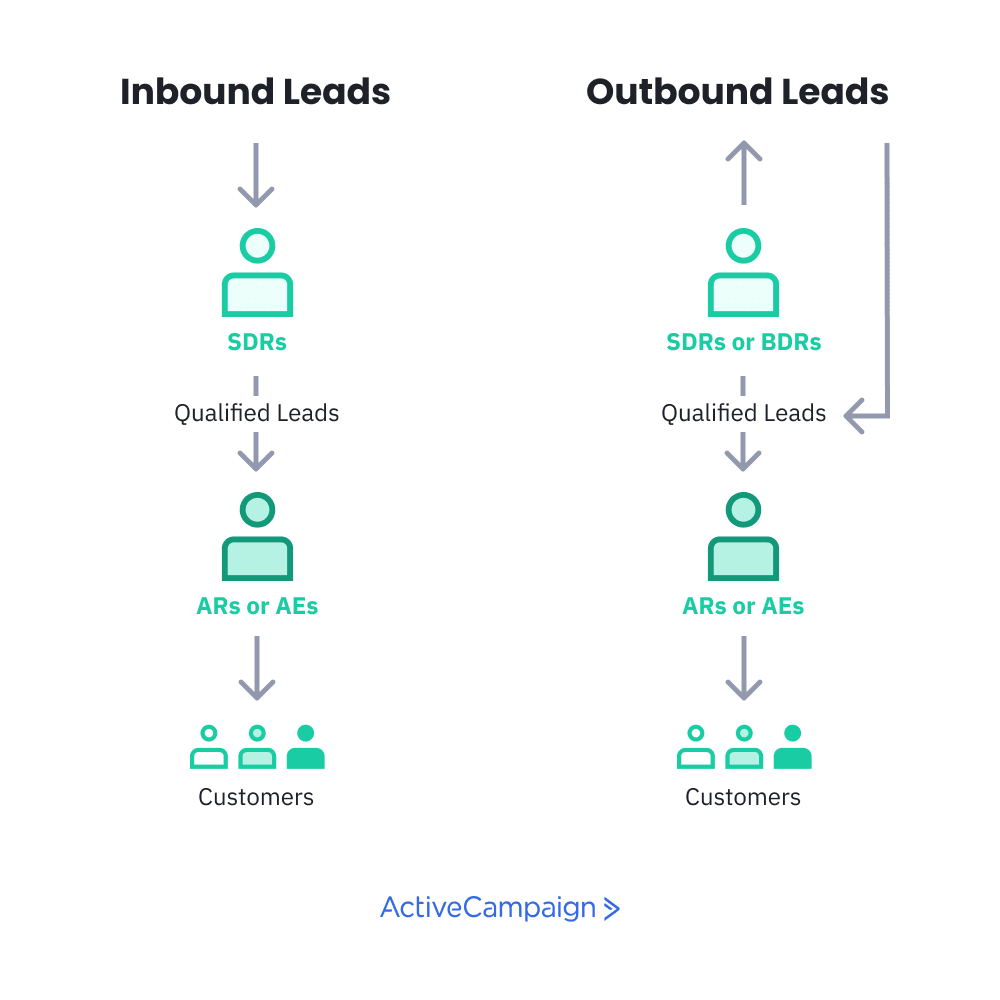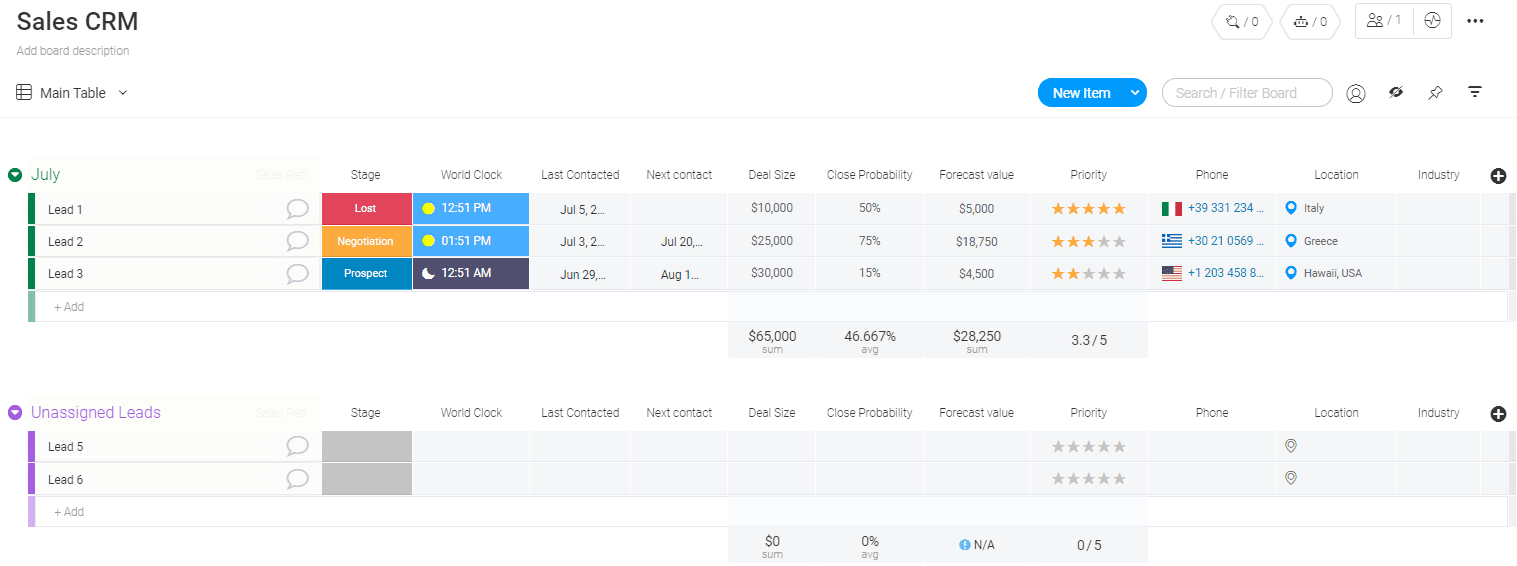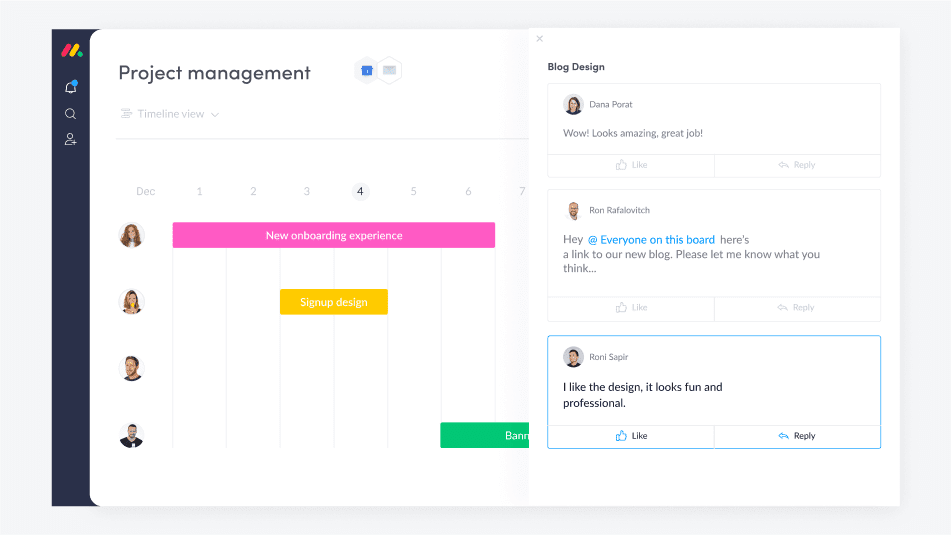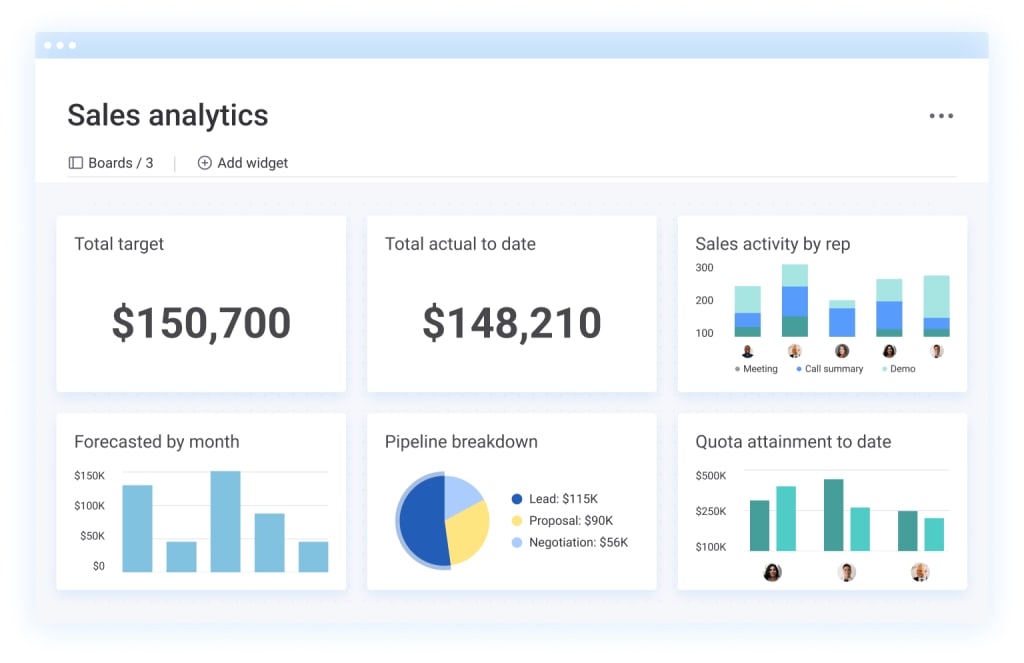B2B businesses can often lose money after sending salespersons across the country to close deals. Plane tickets, hotels, and other reimbursements can quickly add up. It’s a risky approach to winning over new customers, as a single expensive trip that doesn’t close a deal could be detrimental for an early-stage organization.
That’s why businesses need to structure their sales organizations in a way that is cost-efficient and effective. The best way to accomplish that is with an inside sales model.
But what exactly is inside sales? In this post, we’ll explain what exactly this term means, and the benefits of an inside sales team. Plus, we’ll show you three specific strategies that lead to inside sales success, and how to best leverage them with monday.com.
What is inside sales?
Inside sales is the process of remotely selling your product through digital and audio communications, such as email, telephone, or video chat. To put it simply, inside sales representatives can close the sale without leaving the office. They essentially stay “inside” the business.
Beyond the simple definition of inside sales, one might wonder if there are any other differences between inside sales vs. outside sales. Well, there are a few factors to consider. Let’s explore them.
What is the difference between inside sales and outside sales?
Before you decide which sales structure is right for your team, you need to understand the difference.
Whether you’re an inside sales rep or an outside sales rep, your goals are similar: to execute a sales strategy, convert a potential customer, and deliver optimal customer service. However, the mode in which you make the sale and how you work differs greatly. The primary difference between both sales structures is how the sale takes place.
Inside sales can be conducted through virtual channels, like email, virtual phone system, telephone, or video from within the organization. Outside sales rely on a sales team that visits prospective clients in their offices for in-person pitches and demos.
When you compare the 2 structures, an inside sales structure generally costs a business less. Your employees would constantly be working from your offices or their homes, reaching out to new prospective customers. They wouldn’t be limited by in-person meetings.
However, some sales require face-to-face interaction. That’s where outside sales structures come into play. Depending on the type of company and overall deal size, an outside sales structure may be necessary and more effective.
What is the benefit of inside sales?
A research report on the State of Sales conducted by InsideSales.com found that over 52% of sales professionals belong to an outside sales organization:

So let’s take a look look at some of the benefits that contribute to the mass use of inside sales.
- Lower costs: Compared to an outside sales organization that has travel expenses for in-person meetings, inside sales structures are cheaper and more cost-effective. Outside sales teams can quickly drive up costs and splinter employees away from core business teams and units. Plus, deals don’t often close at the first meeting. In fact, only 2% of sales typically close at the first meeting! So, the cost vs. benefit comparison of in-person meetings (outside sales) can be too much for small organizations. Inside sales, on the other hand, counteracts all of these issues.
- Better collaboration between departments: Inside sales employees often work closely together in the same building as all other employees. This can help create sales and marketing alignment as well as a deeper connection between your sales team and other departments.
- Faster deals: It’s much quicker to reach and communicate with people digitally or through the phone than with an in-person meeting. Outside sales teams must account for a lot of extra time to schedule, attend, and travel to meetings.
- Accurate data to draw from: when you’re conducting sales online, it’s a lot easier to automatically record data through a CRM system. It’s also easier to draw from analytics digitally than in person to better understand your targeted customer.
How are inside sales teams structured?
Inside sales teams can be structured in a variety of different ways. One of the most common includes a team of sales development representatives and account executives.
Sales development representatives serve as qualifiers that review inbound leads and execute cold calls. Once there is a qualified lead that wants a meeting, an account executive will take over in an attempt to close the sale.
Think of sales development representatives as the gatekeepers who screen, review, and nurture leads until they are ready to convert. In addition, they’ll proactively conduct calls and outreach to generate outbound leads.

Once the account executives convert the leads, they turn into customers, and the process starts over.
Another key player in this structure that isn’t pictured in the diagram is the marketing team. Sales and marketing teams need to work closely with one another, aligned on shared strategy and goals. This is called sales and marketing alignment. When sales and marketing work well together, the results can be incredible. But when they’re working on different initiatives or heading in different directions, it can be catastrophic for the business.
More than 49% of sales and marketing professionals believe that the main issue that prevents sales and marketing alignment is communication.
Inside sales structures better facilitate sales and marketing alignment, since the sales professionals are working in the same environment as the marketers. They aren’t out traveling to different prospects around the world, but working together in sync.How can you build on this synergy? Let’s take a look at some of the strategies you can deploy for inside sales success.
3 strategies for inside sales success
With your inside sales team set up, it’s now time to optimize it for success. To accomplish this, you should use a CRM to manage prospects, initiate proper sales training, and review what worked in closed sales.
1. Use a CRM to manage prospects
In order for your inside sales team to get to work, they need to have a dashboard to hold all of their open opportunities and prospect data. This dashboard is often in the form of a CRM, or a customer relationship management system.
To start formatting your ideal CRM, you can use monday.com to build the perfect one for your business.
monday.com offers a CRM template that enables businesses to start collecting and filtering prospect information right away, without having to design anything from scratch — unless, of course, you want to.
The CRM template includes cells for data such as:
- Name: first and last name of the prospect
- Stage: where the deal currently is in the sales cycle (i.e., lost, negotiation, closed)
- Clock: the local time for the prospect
- Contact Dates: last time and next time someone will reach out
- Deal Size: overall value of the overall deal
- Close Probability: likeliness of the deal going through
- Forecast Value: estimated value of the deal
- Priority: where the deal falls in line with other open opportunities
- Phone Number: prospect contact information
- Location: city and state where the prospect lives
- Industry: what line of work the prospect’s business is in
With this information, you can begin to get a bird’s-eye-view of your pipeline and which deals may close soon.

Plus, you can automate functions within monday.com to make your CRM more adaptable for your business.
You’ll be able to use automatic calculations, view customer locations on a map layout, and enjoy easy-to-use import and export functions at your fingertips to transfer data as needed. With a functioning CRM, your inside sales team can easily collaborate and close more deals than ever before.
2. Ensure your sales team has all the resources they need
Sales teams that are simply cut loose with no onboarding or acclimation to the company will be doomed to fail.
Successful businesses give their new hires a crash course in the business and outline objectives that new employees should strive to reach that month, quarter and year. Without these objectives and resources, your salespeople might be running in all directions, wasting company resources and missing lucrative opportunities in front of them.
Unfortunately, this scenario is not uncommon for most companies. In fact, over 25% of sales professionals do not believe that they have had sufficient training.
That training could be the difference between closing exponentially more deals. To ensure your sales team has everything they need, consider using a sturdy Work OS . A good Work OS will be available for employees organization-wide so that the resources span across all departments.
You can host sales training materials, documents, dashboards, and other essential items directly in the monday.com Work OS, making it a centralized platform that is always driving value for its users.

In a Work OS, users can communicate with one another, share progress updates, and add comments on open deals. This can ensure that the team is aware of what everyone is working on to ensure that nothing falls through the cracks.
With a Work OS, you can bring your inside sales team together and keep them on track to hit their goals.
3. Review what worked with closed sales
Successful inside sales teams try to figure out their winning formula. While there isn’t a silver bullet that will make every sale close, new discoveries and insights can help sales professionals evolve their pitch and understand what resonated.
Closing sales is no easy task. Finding out what works sometimes requires talking to existing customers. In order to improve their sales skills, inside reps need to review their sales activity and talk to a satisfied client to see what worked.
To do this, they need to look at their closed deals. The best part: it doesn’t have to be challenging to keep track of all your closed deals.
A CRM software makes it easy to review all your closed won deals in one place. On each deal, you’ll be able to review the contact, owner, company, and total deal value. You can even add a notes column to share details about the pitch and overall sales process.

With this function, you can even sort your deals by “Closed won,” review who is the top salesperson in your company, and begin to review some of the top strategies used to convert new sales. This information will help propel other sales professionals to level up and get on their level, ultimately increasing the overall revenue for the company.
monday sales CRM has all the tools to drive your inside sales team to success
The benefits of using a CRM to power your inside sales team are truly endless. But, you need to make sure you’re using a robust, customizable CRM that will save you time and promote team collaboration. And monday sales CRM is a powerful CRM system that can give you just that: our software equips you with innovative features that help you automate repetitive work, centralize customer communication, and organize your data in one place:
- Automations: Easily create automation rules that drive a workflow automatically. They’re very easy to create, require no technical skills, and can help you effortlessly streamline your entire CRM workflow.
- Integrations: Seamlessly integrate all your favorite tools you already use to centralize all your team’s work in one place.
- Dashboards: Keep track of your pipelines, targets, and team performance through visually intuitive dashboards. Customize the dashboards to instantly report on deal progress, sales figures, and team performance.

Supercharge your inside sales team
To recap: inside sales is the act of closing a deal remotely through chat, email, phone, or video conferencing. It is an efficient, low-cost way to structure your sales team. Deals can be made faster since you can reach the prospect quickly over your devices and the team can be better integrated with other business departments.
To optimize your inside sales team, ensure you have sales and marketing alignment. You should use a CRM to manage prospects, initiate proper sales training, and review what worked in closed sales.
By doing this, you’ll set your team up for success, and your organization will be poised for growth. Get started with monday.com today and help your inside sales team manage their leads with a CRM built to fit your unique needs.
Learn more about other type of sales: Direct Sales, B2B Sales, B2C Sales, SaaS Sales, AI Sales

